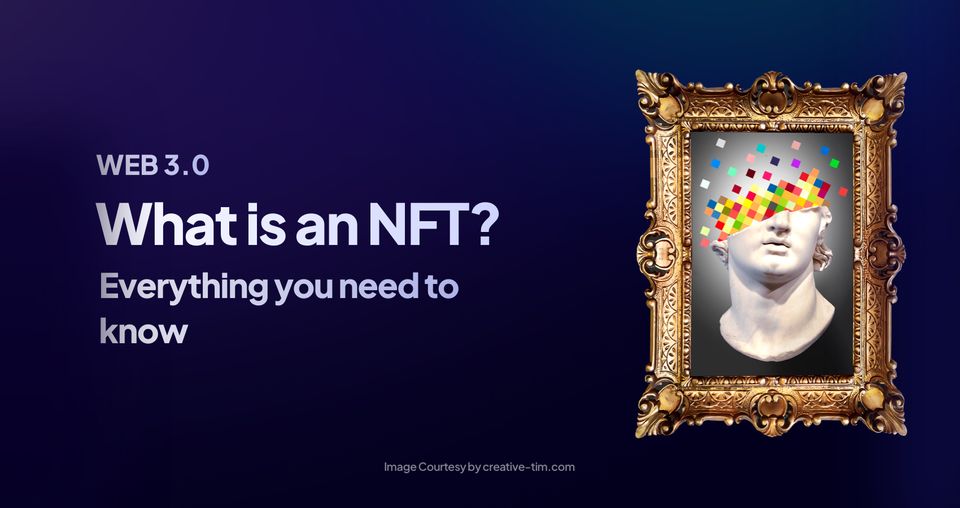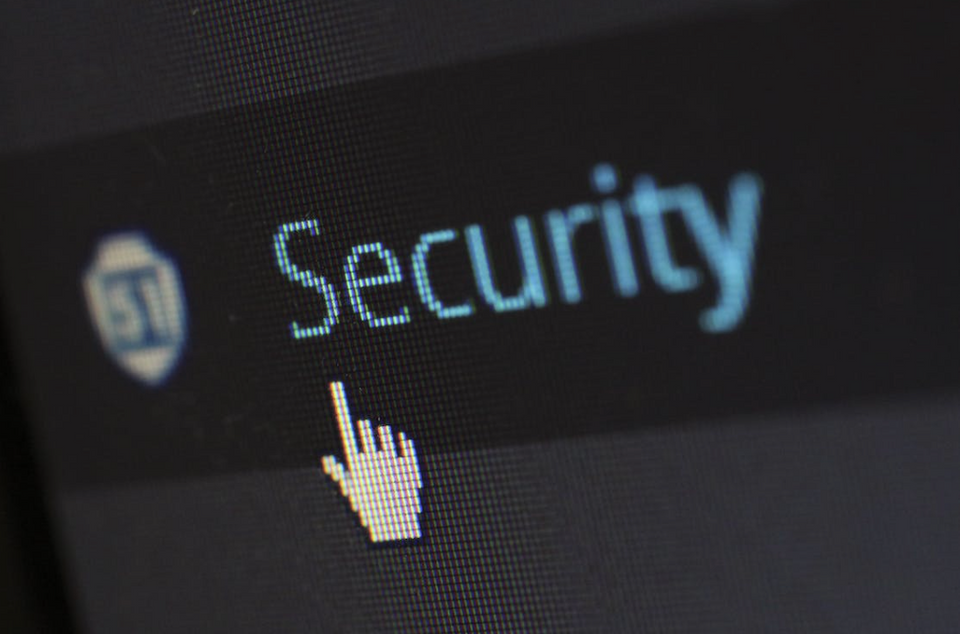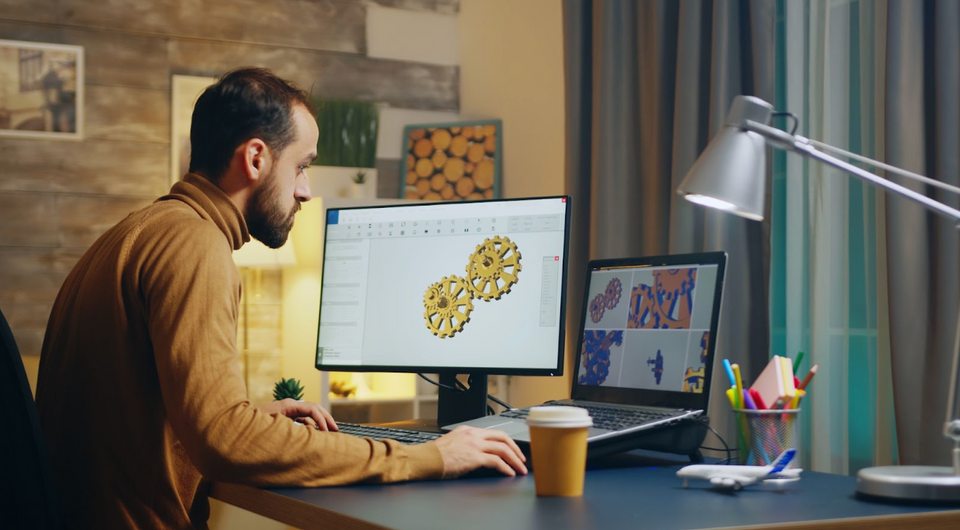Since they took the world by storm in 2021, NFTs have evolved beyond JPEG collectibles to establish themselves as a force in the crypto and Web 3.0 spaces. They have become valuable assets with many uses in the virtual and physical worlds.
New NFT projects with real-world use cases are minted daily, and more people are buying into them. And as different industries — from sports, music, and fine arts to video games — continue to adopt this technology, the future of NFTs seems bright. A recent study by Grand View Research Inc. anticipates that the global NFT market size will grow by almost 40% to a total of $211.72 billion by 2030.
On November 2, during its Creator Week 2022 event, Meta (formerly Facebook) announced that it could allow its creators on Instagram to mint, showcase, and sell digital collectibles and other NFTs on and off the platform, a move that would see NFTs go more mainstream.
It’s clear that NFT is no longer a buzzword; you need to pay attention to this trend, as it is here to stay. This article will explore what NFTs are and everything you need to know about them.
Table of Contents:
1. NFT for Dummies: What Is it?
2. NFTs vs. Crypto: What’s the Difference?
3. A Brief History of NFTs
4. What Are NFTs Used For?
5. How Does an NFT Work?
6. How Can I Buy NFTs?
7. Investing in NFT Stocks
8. Are NFTs Safe?
9. How Can I Create NFTs
10. Examples of NFT Projects
11. Why Are NFTs Important?
Conclusion
1. NFT for Dummies: What Is it?
NFT is an acronym for non-fungible token. They’re tokens in a blockchain representing unique digital or physical assets.
NFTs are tokenized, meaning each and every one of them is unique and unlike any other. And that includes different versions of the asset the NFT is based on. Tokenized assets are attached to a digital certificate of ownership on the blockchain.
NFTs are digital assets, and just like cryptos, they can be bought, sold, and traded by the owner. But to separate them from cryptocurrencies, you must understand what it means to be “non-fungible.”
The most popular cryptocurrency is Bitcoin, and it’s a fungible token. When something is fungible, it can be exchanged for something similar or equal to it in value. 1 BTC is equivalent to every other Bitcoin. But 1 NFT isn’t equal to every other NFT - different NFTs have different values, making them non-fungible assets.
In short, a non-fungible asset is one of a kind and has no equivalent. Think of a famous piece of art like the Mona Lisa; it’s valuable because it’s non-fungible, i.e., irreplaceable.
2. NFTs vs. Crypto: What’s the Difference?
NFTs are often mistaken for crypto. This is because you can rarely talk about NFTs without mentioning crypto, and there are reasons for that.
For starters, they’re both digital assets, and you will likely need crypto to mint, buy, or sell NFTs (some marketplaces also allow fiat currencies).
Additionally, they’re both stored in digital wallets and rely on blockchain technology for transactions to validate their authenticity and to record their ownership. And that’s where the similarities end.
The most significant difference between crypto and NFTs is in the fungibility aspect. Whereas cryptocurrencies are mutually interchangeable, all NFTs are unique with varying values.
The other main difference between the two lies in how they’re brought into circulation. Cryptos are mined, while NFTs are minted. Mining involves a miner using a computer to perform an accounting function to verify transactions on the blockchain, and they’re paid in new coins. Minting, on the other hand, involves converting a file (e.g., a .jpeg image) into a token to be usable in the blockchain.
In summary, here are the key differences between NFTs and crypto:
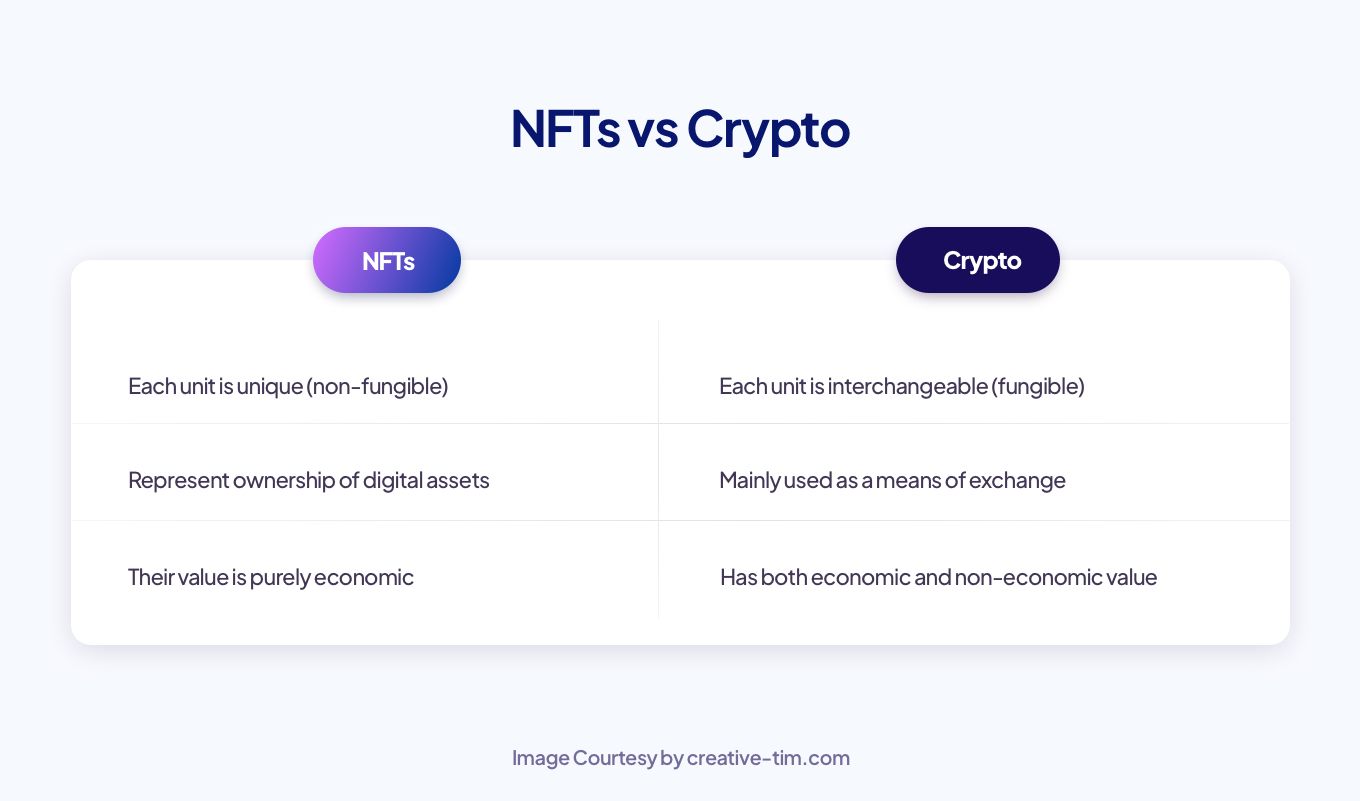
3. A Brief History of NFTs
While it gained mainstream popularity in 2021 after Beeble’s Everdays: the First 5000 Days NFT sold for $69 million, NFTs can trace their roots back to 2012. And even though NFTs are mostly associated with the Ethereum blockchain, the technology precedes it by three years. Here is a breakdown of the key events in NFTs’ life:
2012-2016 – The Early Days
Meni Rosenfield released a white paper that introduced the “Colored Coins” concept for the Bitcoin blockchain in 2012. The idea was to create a class of methods to represent and manage real-world assets on the blockchain to prove their ownership. Colored Coins would have been similar to Bitcoin but with the “token” element to determine their use, making them unique.
The Coloured Coins concept wasn’t released due to Bitcoin limitations; however, it laid the foundation for what would become NFTs.
In 2014, Kevin McCoy, a digital artist, minted the first NFT “Quantum” on the Namecoin blockchain. This event opened the stage for more experimentation and development on different blockchains. The Counterparty Platform (also known as Bitcoin 2.0) was established, and together with the Ethereum blockchain (Oct. 2015), they gained ground and enabled the creation of digital assets.
In 2015, Spells of Genesis issued the initial tokenized digital collectibles that were used in their game. And by 2016, popular memes were being minted as NFTs.
2017-2020 – The Adoption Phase
In 2017, NFTs made a significant shift to the Ethereum blockchain after introducing a set of standards that allowed developers to create NFTs. With this, the first mainstream project, CryptoPunks, was born. Its developers created 10,000 different pieces of characters and offered them for free. The most expensive Punk, #5822, sold for $23.7 million in February 2022.
More people could adopt NFTs thanks to the rise of NFT gaming. The first mainstream project was CryptoKitties. The virtual game was based on the Ethereum blockchain and allowed players to adopt, breed, and trade virtual cats and store them in crypto wallets.
With the success of NFT gaming came metaverse projects. The first on the scene was Decentraland (MANA). The project was based on the Ethereum blockchain and designed to enable the ownership of lands as digital assets on their ledger.
Soon, other blockchain-based games and platforms emerged. Developers started to tokenize their in-game items and assets in the metaverse to give them value in the real world using cryptocurrencies such as Enjin Coin.
2021 – The Golden Age
The demand for NFTs went through the roof in 2021 after traditional art auction houses Sotheby’s and Christie’s moved into the scene and began selling NFTs. This validated the significance of NFTs, and it wasn’t long before celebrities joined the train, and NFT millionaires were born.
While Ethereum was still the biggest NFT platform, other cryptocurrencies like Tezos, Cardano, and Solana created their versions. Soon, NFT marketplaces were setting new trading records every other day. The growth of NFTs further spiked towards the end of 2021 when Facebook rebranded to Meta and went into the metaverse.
4. What Are NFTs Used For?
NFTs allow for the tokenization of digital and real-world assets to prove ownership through smart contracts. This unique phenomenon has allowed it to gain mainstream interest and adoption in various industries.
One of the most popular uses of NFTs can be seen in online gaming. Developers can sell rare items as in-game purchases to generate more revenue, while players can participate in Play-To-Earn NFT games to collect items as a reward. They can use the items, exchange or even sell them to other gamers.
Let’s look at some of the other most notable use cases of NFTs:
- NFT collectibles. Crypto collectibles are unique and limited-edition digital items authenticated using blockchain technology. They feature unique algorithms that give them added value. One of the most famous NFT collectibles is Bored Ape Yacht Club, or BAYC, featuring a template of an animated ape. All BAYC NFTs have different designs.
- NFT certificates and licenses. NFTs have made it easy to tokenize certificates and licenses to verify their authenticity and ownership. Duke University became one of the first institutions to offer educational credentials as NFTs. Students who completed a course on blockchain were given their certificates as unique digital tokens.
- NFT art is easily one of the most common use cases for NFTs. Digital artists, musicians, photographers, and other creatives have struggled to monetize their art or prove their ownership for a long time. NFTs solved this problem. All these artists can now sell their digital and real-world art to the highest bidder and generate income from their talent.
- NFT utility offer use cases beyond their valuation, such as rolling membership benefits, access to premium, gated content or exclusive entry to real-world experiences. Check Creative Tim's utility NFTs project, NF-Tim, that gives instant access through their nfts to hundreds of premium products for developers and designers.
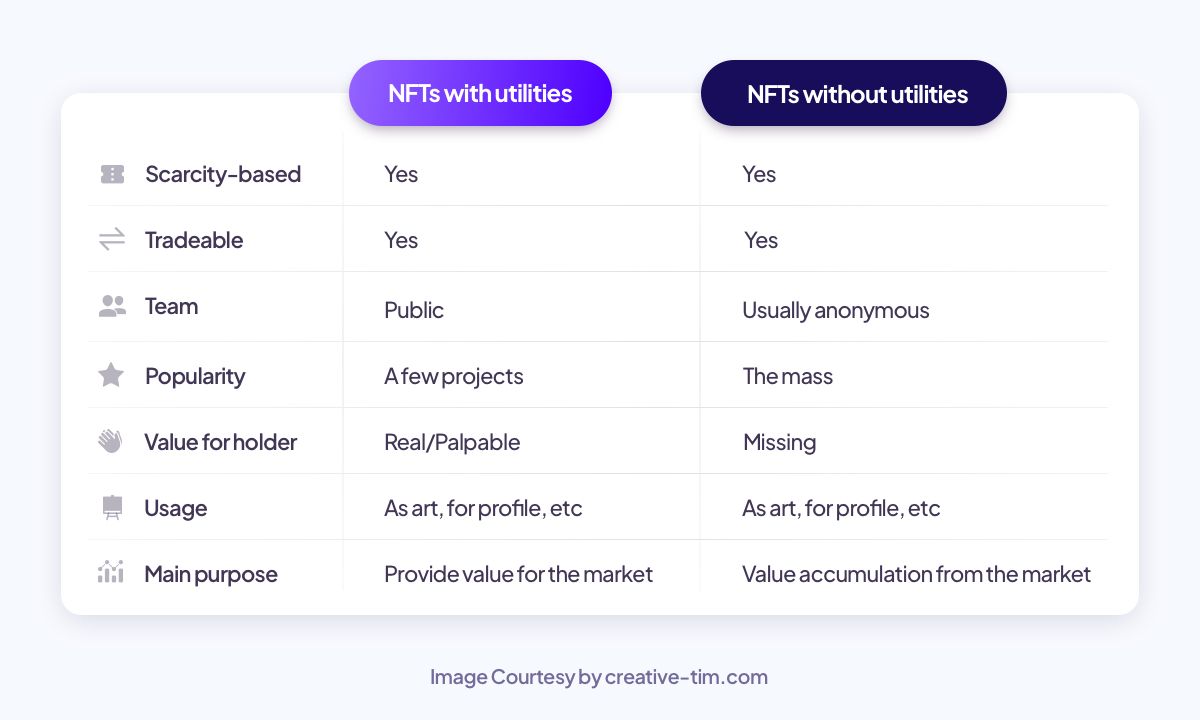
5. How Does an NFT Work?
Non-fungible tokens are managed in the blockchain; that is, they’re on a decentralized ledger that keeps ownership and transaction records. Each NFT has a smart contract that contains a code, a unique ID, and metadata like the name of the person who minted the items, how they exchanged hands, who currently owns it, and so on.
But to truly grasp how NFTs work, you must understand two of its most attractive features:
- Scarcity: The NFT creator decides how many items to mint and how many replicas there should be. Each of them will be different from the others. If they choose to create one, the item will be rare. Take BAYC, for example; there can only be 10,000 of them, and each is different. A person can create new ones that look like them, but they won’t be considered part of the original collectibles, and there are smart contracts to confirm that. From there, the owner can decide whether to sell or hold onto their items.
- Royalties: NFT creators get to set the rules that will govern ownership and transferability when minting their items. During the process, they can program the smart contract to automatically allocate a share of the amount paid for any sale to the original owner. This ultimately allows them to earn royalties every time their item changes hands.
6. How Can I Buy NFTs?
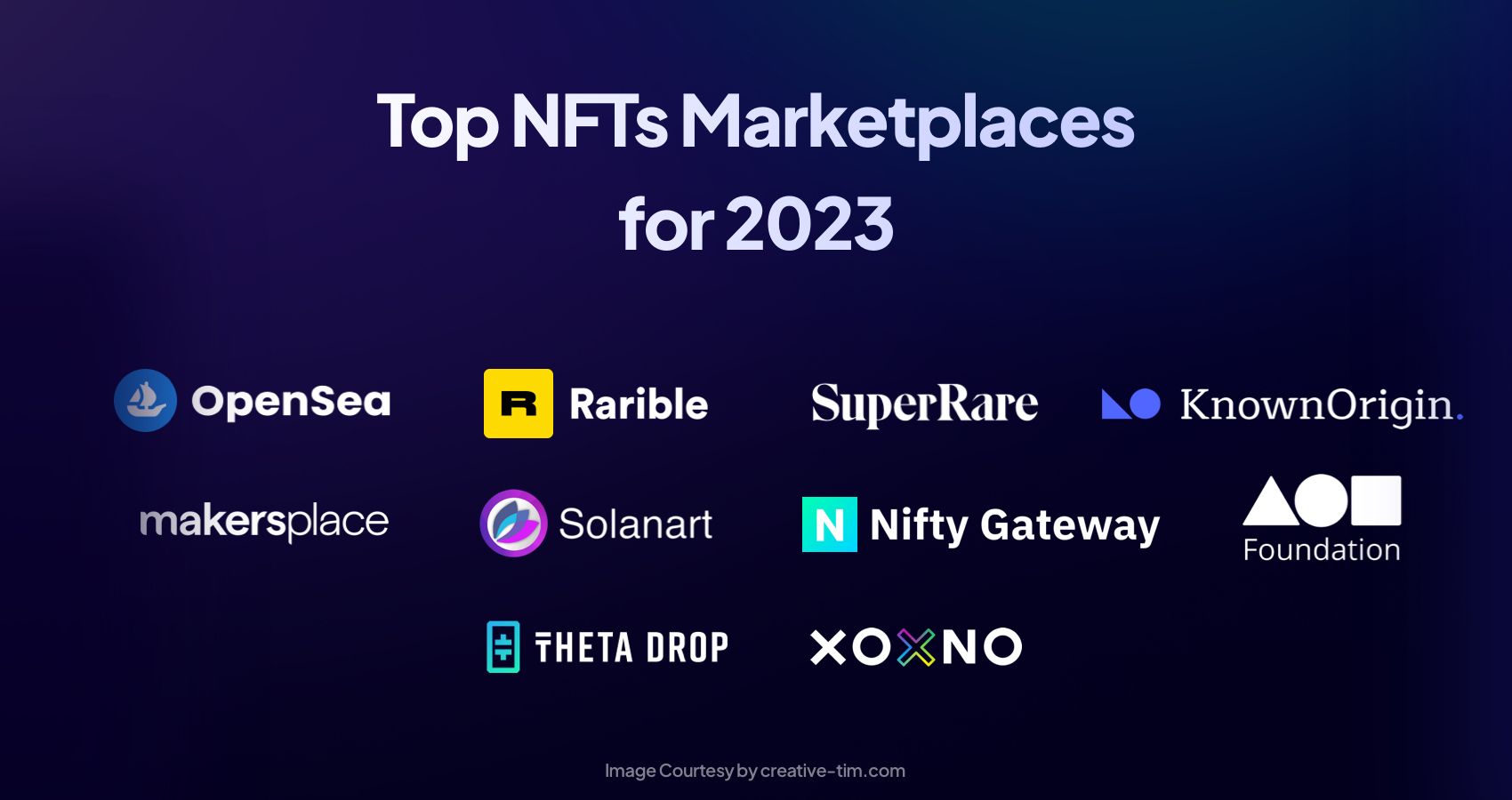
Trading NFTs happens on NFT marketplaces. If you want to invest in this market, the process is pretty straightforward.
Here’s a step-by-step guide to how to buy NFTs as a beginner:
- Step 1: Buy crypto and save it in your wallet. You will likely need crypto, such as Bitcoin, Ethereum, etc., to purchase an NFT. Ensure that you have enough crypto in your wallet to buy the NFT and pay the transaction fees.
- Step 2: Choose the NFT you want to buy. It can be anything from art, digital collectibles, music, photographs, etc.
- Step 3: Choose a marketplace. Think of a marketplace as the eBay of NFTs, where you go shopping when you want to buy a rare digital item. The marketplace you pick will be dictated by where the NFT you wish to purchase is located. Some of the most popular NFT marketplaces include Rarible, Opensea, Mintable, Foundation, etc. There are also general and specific markets that sell specific types of NFTs.
- Step 4: Connect or set up your crypto wallet. To buy an NFT, you need to open and link your crypto wallet on the marketplace. Your crypto wallet should contain the cryptocurrencies the marketplace accepts. The wallet will be used to send the crypto to purchase the NFT, receive it, and store it.
- Step 5: Place your bid and buy your NFT. Depending on the marketplace, you will buy NFTs directly or through an auction. You can pay and complete the purchase if the owner has set a fixed price. If it’s an auction, the item will typically go to the highest bidder when it closes.
Some NFTs projects might include a KYC process too, that makes the project more trustworthy and more "legal". Like the projects from Bhero launchpad. The KYC process is a data-driven process that allows crypto businesses to verify the identity of their customers in order to prevent money laundering, terrorism financing, and other illegal activities.
7. Investing in NFT Stocks
If you are not sold on the idea of buying NFTs, you can still invest in NFTs through NFT stocks.
NFT stocks are stocks of publicly listed companies that deal with NFTs. If they make a profit through their dealings with NFT, it will be reflected in their company profits. This can be through the minting of their own NFTs or trading NFTs. These activities will drive their stock price up, and that’s how you make profits on your investment.
To buy NFT stocks, you will need to find a regulated broker and create an account with them. Then, you will purchase NFT stocks the same way you would any other company’s shares. Ensure you do enough research when choosing a broker and NFT stock to buy.
8. Are NFTs Safe?
Like any other investment, NFTs come with their fair share of risks. You, as an investor, should be aware of those risks and take calculated moves to avoid them. The most considerable risk associated with NFTs is price swings since their values are mostly denoted in cryptos, which are highly volatile assets.
To ensure your safety when investing in NFTs, make sure to:
- Conduct proper research before you buy or invest in NFTs
- Set up a wallet with a reputable provider
- Protect your wallet with a secure password and set up multifactor authentication
- Protect your devices with cybersecurity software like antivirus and antimalware
- Safely store your private keys and seed phrases
As you take steps to protect yourself when investing in NFTs, you must understand some of the most common NFT scams that can lead to losses. As NFTs grow and gain momentum, cybercriminals are devising new ways to target the community. And in most instances, new traders are affected the most.
Some of the NFT scams to be on the lookout for include the following:
- Fake marketplaces
- Phishing NFT scams
- Criminals posing as customer support
- Rug pulls - meaning a scam promotion of a crypto token via social media
- Pump-and-dump schemes
- Social engineering attacks, etc.
9. How Can I Create NFTs
Another way to invest in NFTs is to create or mint your own. Minting refers to the process of publishing unique digital assets on the blockchain so that they can be stored, sold, and traded. While it might sound complex, creating NFTs is straightforward, and you can create one by following these steps.
- Step 1: Select your digital item - what do you want to mint? Anything that has digital or physical utility can be turned into an NFT. If you are a photographer, it can be a picture. If you are a web designer, it can be a website theme. If you are a homeowner, it can be your house.
- Step 2: Since you will need a place to store your cryptocurrencies and NFTs, set up a digital wallet. You also need a crypto wallet because minting is not free. Most marketplaces will charge you what’s known as a “gas fee” during the process, and you’ll have to pay these fees from your digital wallet. Once you have your wallet, load it with crypto. Most marketplaces use Ethereum, so you might want to go with the ether token. However, be prepared to exchange to a different cryptocurrency if the marketplace allows for a different coin.
- Step 3: Pick a marketplace. This represents where you want to sell or store your created NFTs. We have already mentioned some popular marketplaces you can use depending on your needs. Once you go to the marketplace, follow the prompts to start the process. But before you get started, ensure you connect your crypto wallet to the NFT marketplace. This will enable you to pay the gas fee and receive payments if you sell your digital assets.
- Step 4: Upload your NFT in the marketplace. To start the minting process and turn your digital item into an NFT, you will need to upload it to the marketplace. Most platforms will provide a how-to guide you can follow to avoid any mistakes.
- Step 5: Mint and share. Once your file is uploaded, it’s time to create a smart contract. Input a title, description, and every other relevant detail. If you want to sell your NFT, you can request royalties every time it’s traded.
- Step 6: Choose the blockchain you want to mint on. Is it the Ethereum blockchain or the Solana one? The decision is up to you and will be dictated by how much you want to spend on the gas fee. Once you’ve triple-checked everything, click on the “Mint” or “Create” button on the marketplace. Voila! You’ve just minted your first NFT.
If you will choose MultiversX (former Elrond) as blockchain for your project, there is already an open-source tool for developers - a starter template for NFTs collection creators. The dApp features include: showcasing all the NFTs that you own from a specific collection with details, login process using the cryptocurrency wallet, and an innovative design by Creative Tim.
10. Examples of NFT Projects
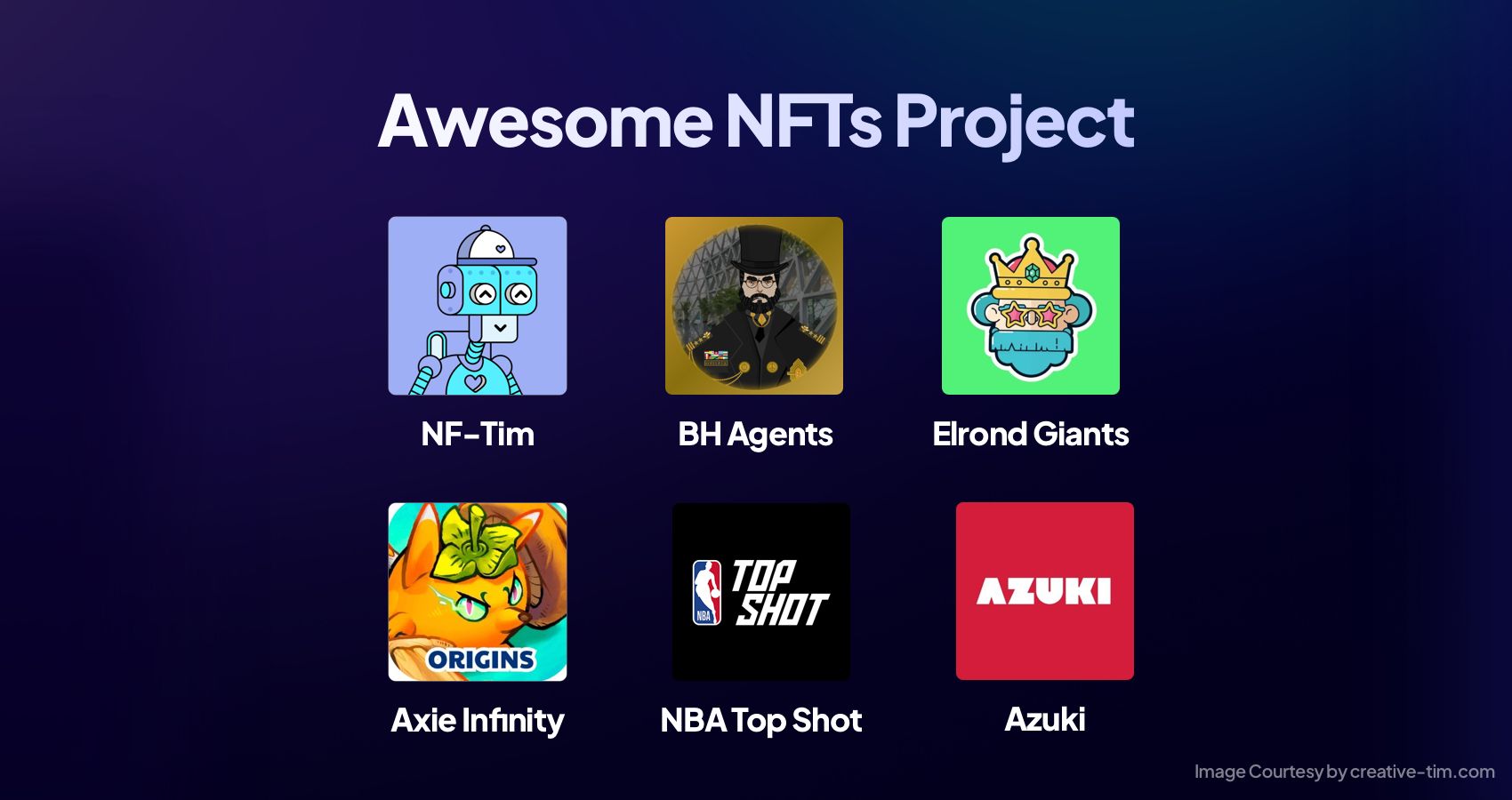
An NFT project is a unique collection of NFTs produced at a large scale by a big organization that is often traded on its own platform. Unlike NFTs created by individual artists, they are not available at popular marketplaces.
Here’s a list of some of the biggest NFT projects:
- NF-Tim. This NFT project is a 9,999 NFT collection and is the first NFT utility project for developers and designers based on the Elrond blockchain. Each of the NFTs will give you access to premium products by Creative Tim.
- BH Agents is a BH Network NFT collection that provides the community and holders with continuous perks and rewards. The BH Agents collection project comprises 10,000 NFTs.
- Elrond Giants. The project is a collection of 10,000 NFTs on the Elrond blockchain. Each Giant serves as a membership card, granting access to members-only features such as passive income, airdrops, priority access, and other earning possibilities.
- Axie Infinity. This is a Play-To-Earn NFT concept game generalized in the blockchain. Players complete gaming tasks to breed charming NFT animals called Axies.
- NBA Top Shot. This is an NFT project where basketball fans can collect “NBA moments.” An NBA Moment is a package of NBA highlight clips.
- Azuki. This NFT project is inspired by Japanese-style anime. The project was created by Chiru Labs in early 2022 and is composed of four anonymous youths.
11. Why Are NFTs Important?
In 2021, when NFTs went mainstream, everyone bought and traded NFTs because they did not want to miss out. But that’s no longer the case, given how the industry has developed based on the real-world use cases it has now. So why are NFTs still popular? Here are the three main reasons:
- They have made it easy to trade precious items thanks to smart contracts that prove ownership and authenticity in the blockchain.
- Celebrities and global corporations have embraced NFTs giving them more validation.
- NFTs have the potential to generate passive income thanks to the royalties aspect.
Conclusion
The hype might have died, but NFTs are very much alive. Whether you are a creative wanting to monetize your art or simply looking for investment opportunities, NFTs present many possibilities.
Now that you know the meaning of NFTs and everything in between, deciding the route to take shouldn’t be too hard.
References:
- What is Web 3.0?
- Web 1.0 vs Web 2.0 vs Web 3.0. What are the differences?
- 25 Essential Web 3.0 Terms You Need to Know to Understand It
- What is Blockchain Technology and How Does it Work?
- Top 10+ Blockchain Networks to look for in 2023
- Non-Fungible Token (NFT): What It Means and How It Works
- What is NFT and How Does NFT Work? The Ultimate Guide
- NFTs, explained
- What Is An NFT? Non-Fungible Tokens Explained
- What is an NFT and how does it work?
- NFTs Explained: A Must-Read Guide to Everything Non-Fungible

